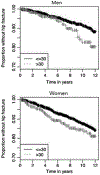Age-Related Factors Associated With The Risk of Hip Fracture
- PMID: 36889582
- PMCID: PMC10258141
- DOI: 10.1016/j.eprac.2023.03.001
Age-Related Factors Associated With The Risk of Hip Fracture
Abstract
Objective: Advancing age is a powerful risk factor for hip fractures. The biological mechanisms through which aging impacts the risk of hip fractures have not been well studied.
Methods: Biological factors associated with "advancing age" that help to explain how aging is associated with the risk of hip fractures are reviewed. The findings are based on analyses of the Cardiovascular Health Study, an ongoing observational study of adults aged ≥65 years with 25 years of follow-up.
Results: The following 5 age-related factors were found to be significantly associated with the risk of hip fractures: (1) microvascular disease of the kidneys (albuminuria and/or elevated urine-albumin-to-creatinine ratio) and brain (abnormal white matter disease on brain magnetic resonance imaging); (2) increased serum levels of carboxymethyl-lysine, an advanced glycation end product that reflects glycation and oxidative stress; (3) reduced parasympathetic tone, as derived from 24-hour Holter monitoring; (4) carotid artery atherosclerosis in the absence of clinical cardiovascular disease; and (5) increased transfatty acid levels in the blood. Each of these factors was associated with a 10% to 25% increased risk of fractures. These associations were independent of traditional risk factors for hip fractures.
Conclusion: Several factors associated with older age help to explain how "aging" may be associated with the risk of hip fractures. These same factors may also explain the high risk of mortality following hip fractures.
Keywords: autonomic function; hip fracture; microvascular disease; oxidative stress; subclinical atherosclerosis; transfatty acids.
Copyright © 2023 AACE. Published by Elsevier Inc. All rights reserved.
Conflict of interest statement
Disclosure The authors have no multiplicity of interest to disclose. The content is solely the responsibility of the authors and does not necessarily represent the official views of the National Institutes of Health.
Figures





References
-
- Cummings SR. Are patients with hip fractures more osteoporotic? Review of the evidence. Am J Med. 1985;78(3):487–494. - PubMed
-
- Wainwright SA, Marshall LM, Ensrud KE, Cauley JA, Black DM, Hillier TA, Hochberg MC, Vogt MT, Orwoll ES; Study of Osteoporotic Fractures Research Group. Hip fracture in women without osteoporosis. J Clin Endocrinol Metab. 2005;90(5):2787–2793. - PubMed
-
- Sanders KM, Nicholson GC, Watts JJ, Pasco JA, Henry MJ, Kotowicz MA, Seeman E. Half the burden of fragility fractures in the community occur in women without osteoporosis. When is fracture prevention costeffective? Bone. 2006;38 (5):694–700. - PubMed
Publication types
MeSH terms
Substances
Grants and funding
- N01 HC085080/HL/NHLBI NIH HHS/United States
- U01 HL080295/HL/NHLBI NIH HHS/United States
- N01 HC085082/HL/NHLBI NIH HHS/United States
- U01 HL130114/HL/NHLBI NIH HHS/United States
- N01 HC055222/HL/NHLBI NIH HHS/United States
- N01 HC085079/HL/NHLBI NIH HHS/United States
- 75N92021D00006/HL/NHLBI NIH HHS/United States
- R01 AG023629/AG/NIA NIH HHS/United States
- N01 HC085081/HL/NHLBI NIH HHS/United States
- R01 DK081373/DK/NIDDK NIH HHS/United States
- HHSN268200800007C/HL/NHLBI NIH HHS/United States
- N01 HC085086/HL/NHLBI NIH HHS/United States
- N01 HC085083/HL/NHLBI NIH HHS/United States
- HHSN268201200036C/HL/NHLBI NIH HHS/United States
- HHSN268201800001C/HL/NHLBI NIH HHS/United States
LinkOut - more resources
Full Text Sources
Other Literature Sources
Medical

